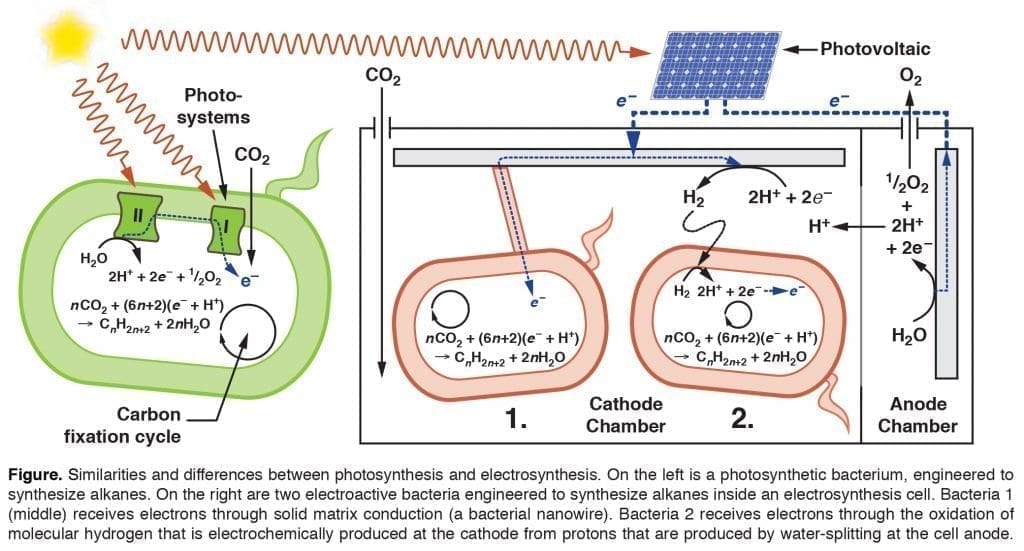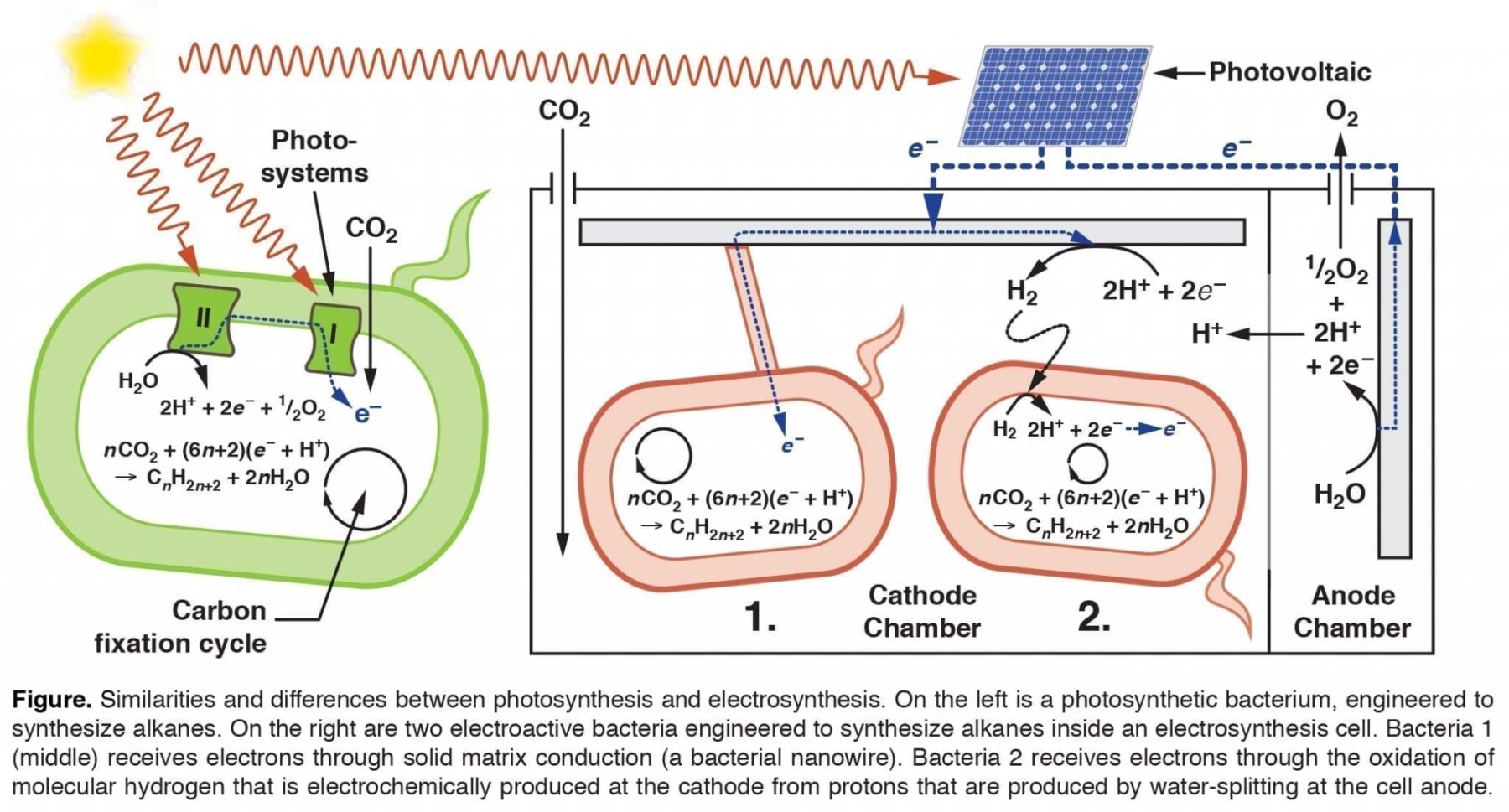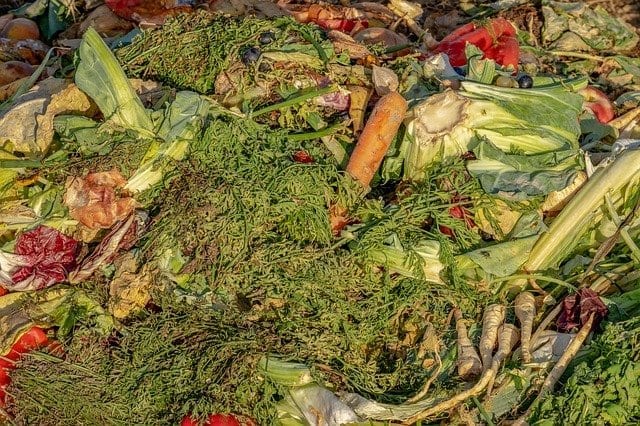
One of the big issues with sustainable energy systems is how to store electricity that’s generated from wind, solar and waves. At present, no existing technology provides large-scale storage and energy retrieval for sustainable energy at a low financial and environmental cost.
Engineered electroactive microbes could be part of the solution; these microbes are capable of borrowing an electron from solar or wind electricity and using the energy to break apart carbon dioxide molecules from the air. The microbes can then take the carbon atoms to make biofuels, such as isobutanol or propanol, that could be burned in a generator or added to gasoline, for example.
“We think biology plays a significant role in creating a sustainable energy infrastructure,” said Buz Barstow, assistant professor of biological and environmental engineering. “Some roles will be supporting roles and some will be major roles, and we’re trying to find all of those places where biology can work.”
Barstow is the senior author of “Electrical Energy Storage With Engineered Biological Systems,” published May 3 in the Journal of Biological Engineering.
Adding electrically engineered (synthetic or non-biological) elements could make this approach even more productive and efficient than microbes alone. At the same time, having many options also creates too many engineering choices. The study supplies information to determine the best design based on needs.
“We are suggesting a new approach where we stitch together biological and non-biological electrochemical engineering to create a new method to store energy,” said Farshid Salimijazi, a graduate student in Barstow’s lab and the paper’s first author.
Natural photosynthesis already offers an example for storing solar energy at a huge scale, and turning it into biofuels in a closed carbon loop. It captures about six times as much solar energy in a year as all civilization uses over the same time. But, photosynthesis is really inefficient at harvesting sunlight, absorbing less than one percent of the energy that hits photosynthesizing cells.
Electroactive microbes let us replace biological light harvesting with photovoltaics. These microbes can absorb electricity into their metabolism and use this energy to convert CO2 to biofuels. The approach shows a lot of promise for making biofuels at higher efficiencies.
Electroactive microbes also allow for the use of other types of renewable electricity, not just solar electricity, to power these conversions. Also, some species of engineered microbes may create bioplastics that could be buried, thereby removing carbon dioxide (a greenhouse gas) from the air and sequestering it in the ground. Bacteria could be engineered to reverse the process, by converting a bioplastic or biofuel back to electricity. These interactions can all occur at room temperature and pressure, which is important for efficiency.
The authors point out that non-biological methods for using electricity for carbon fixation (assimilating carbon from CO2 into organic compounds, such as biofuels) are starting to match and even exceed microbes’ abilities. However, electrochemical technologies are not good at creating the kinds of complex molecules necessary for biofuels and polymers. Engineered electroactive microbes could be designed to convert these simple molecules into much more complicated ones.
Combinations of engineered microbes and electrochemical systems could greatly exceed the efficiency of photosynthesis. For these reasons, a design that marries the two systems offers the most promising solution for energy storage, according to the authors.
“From the calculations that we have done, we think it’s definitely possible,” Salimijazi said.
The paper includes performance data on biological and electrochemical designs for carbon fixation. The current study is “the first time that anybody has gathered in one place all of the data that you need to make an apples-to-apples comparison of the efficiency of all these different modes of carbon fixation,” Barstow said.
In the future, the researchers plan to use the data they have assembled to test out all possible combinations of electrochemical and biological components, and find the best combinations out of so many choices.
Learn more: Engineered bacteria could be missing link in energy storage
The Latest on: Electroactive microbes
[google_news title=”” keyword=”electroactive microbes” num_posts=”10″ blurb_length=”0″ show_thumb=”left”]
via Google News
The Latest on: Electroactive microbes
- Sourdough under the microscope reveals microbes cultivated over generationson May 7, 2024 at 5:00 am
Mixing them produces a live culture where yeast and bacteria ferment the sugars in flour, making byproducts that give sourdough its characteristic taste and smell. They are also what make it rise ...
- Microbe-loaded contact lens lubricates itselfon May 2, 2024 at 5:00 pm
Contact manufacturers often impregnate lenses with wetting agents. “But of course, at some point, after a few hours, the contact lens is empty,” says Aránzazu del Campo, a biomaterials ...
- Microbes and More Newson April 25, 2024 at 5:00 pm
The newly-discovered bacterial symbiont is closely related to the ... Marine Bacteria Team Up to Produce a Vital Vitamin May 8, 2024 — Two species of marine bacteria from the North Sea have ...
- Cell Host & Microbeon April 23, 2024 at 9:31 am
Cell Host & Microbe is a peer-reviewed scientific journal published by Cell Press. The journal was first launched in March 2007 and focuses broadly on the study of microbes, with an emphasis on ...
- Bacteria for climate-neutral chemicals of the futureon April 22, 2024 at 4:59 pm
Bacteria that feed on methanol, known as methylotrophs, are at the centre of these efforts. Containing just a single carbon atom, methanol is one of the simplest organic molecules and can be ...
- Marine microbes can tell us about global changes in the oceanon April 21, 2024 at 2:51 pm
Marine microbes have historically been less explored compared to animal and plant populations, which have significantly enriched our understanding of ecosystem processes and evolutionary adaptations.
- Scientists discover how soil microbes survive in harsh desert environmentson April 16, 2024 at 5:01 pm
But these microbes live in a challenging environment, facing long periods of drought with infrequent rain. Until now, it was unclear how they could maintain important ecosystem functions under ...
- Soil bacteria link their life strategies to soil conditions: Studyon April 16, 2024 at 5:01 pm
Soil bacteria help regulate the cycling of carbon and nutrients on Earth. Over time, these bacteria have evolved strategies that determine where they live, what they do, and how they deal with a ...
- Foodborne Bacteria Have 'Vampiric' Lust for Bloodon April 16, 2024 at 11:02 am
Some of the world's deadliest bacteria appear to have a taste for human blood, a new study has found. Researchers have called this phenomenon "bacterial vampirism." It offers new insights into the ...
- Coral reef microbes point to new way to assess ecosystem healthon April 15, 2024 at 5:00 pm
A new study shows that ocean acidification is changing the mix of microbes in coral reef systems, which can be used to assess ecosystem health. A new study shows that ocean acidification is ...
via Bing News











